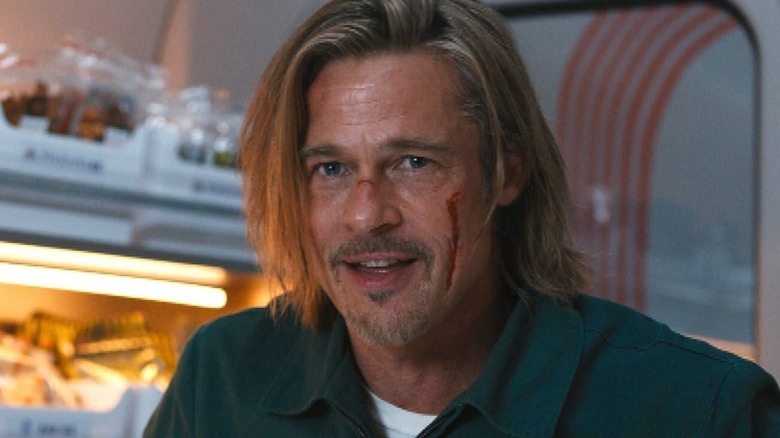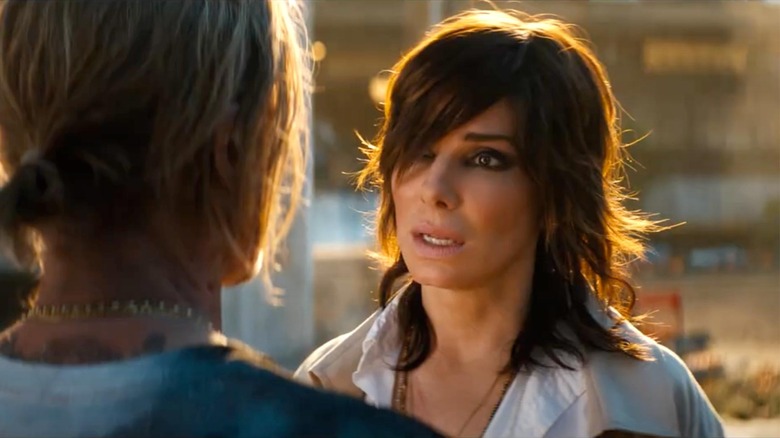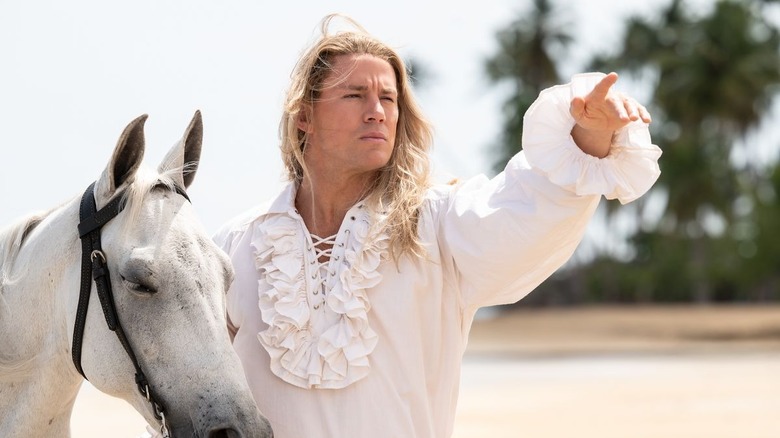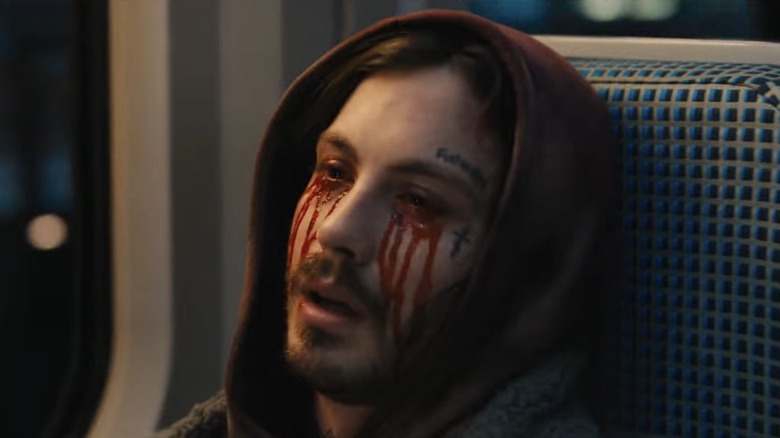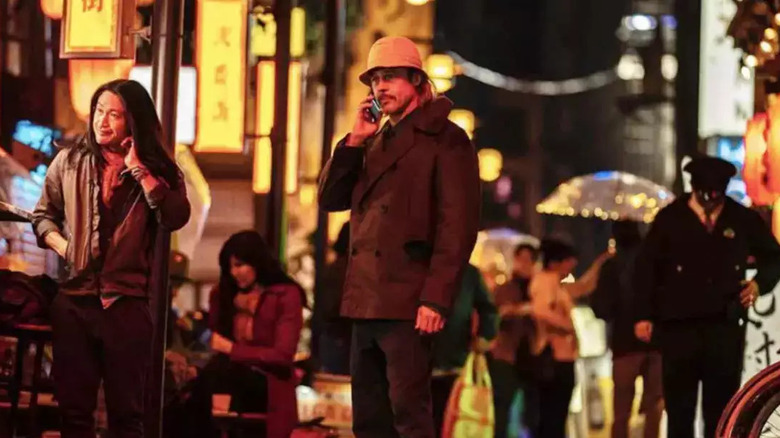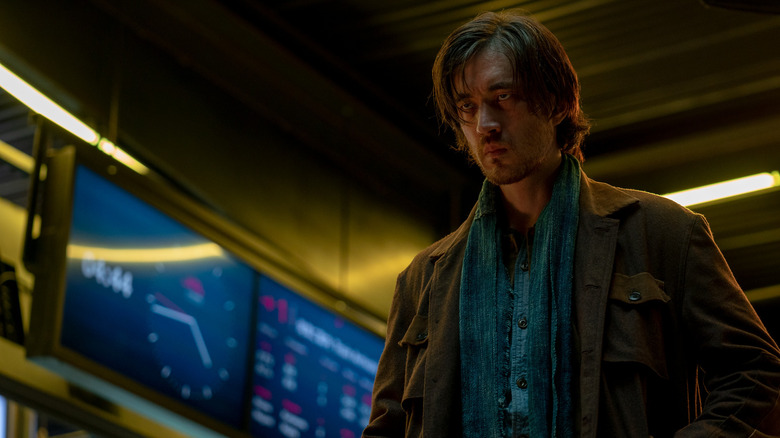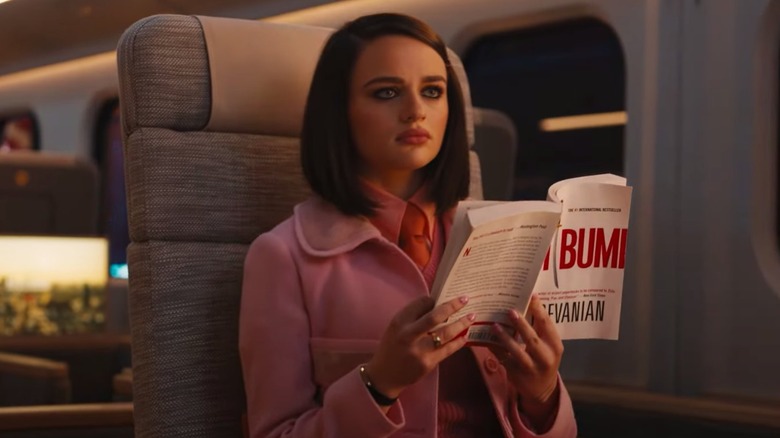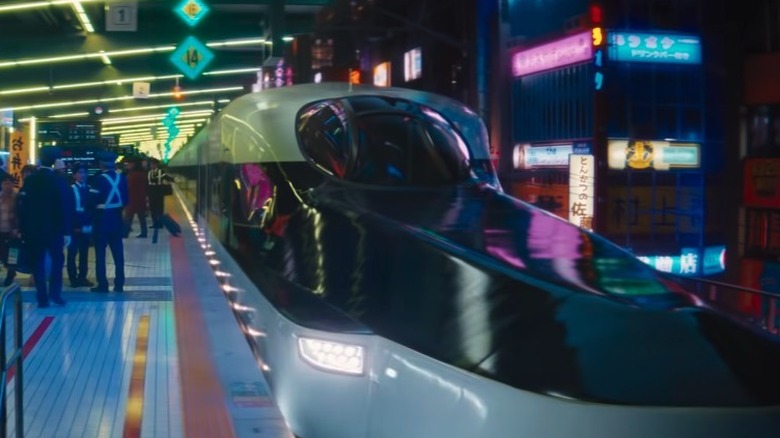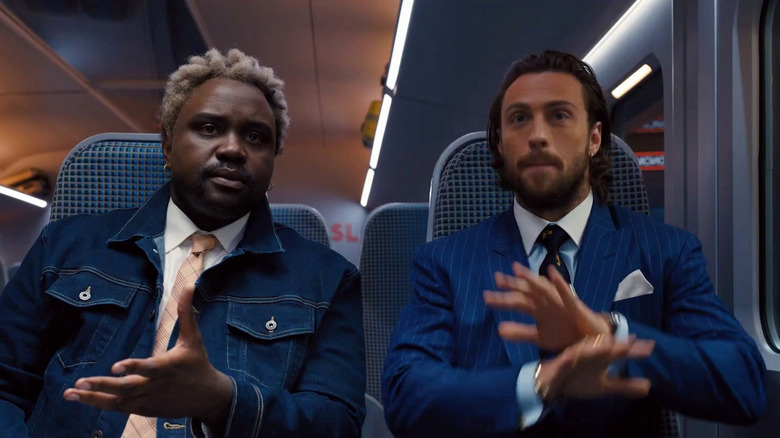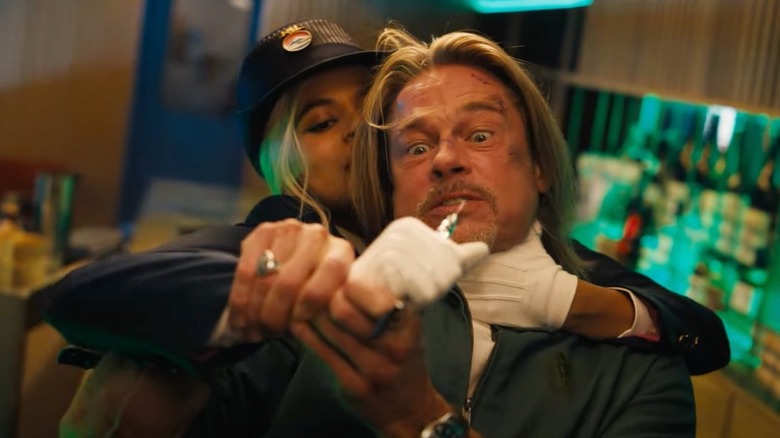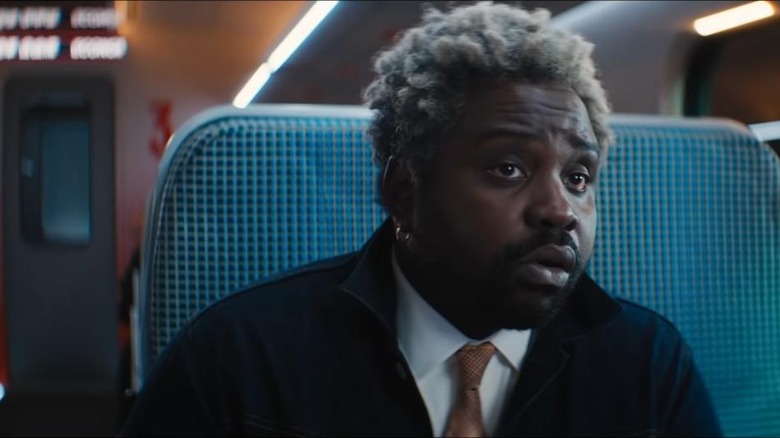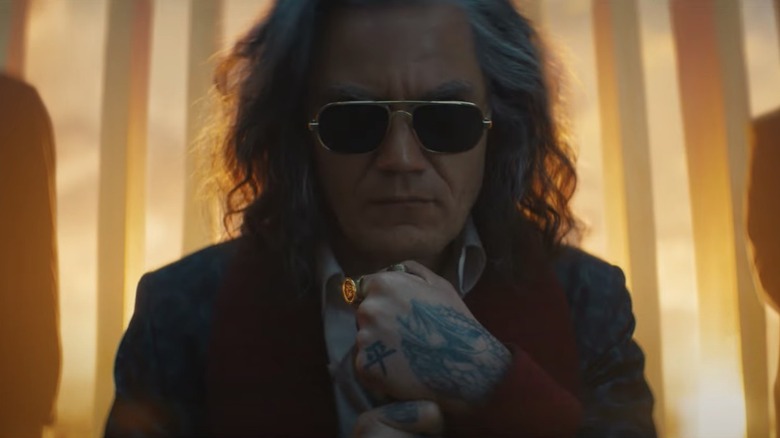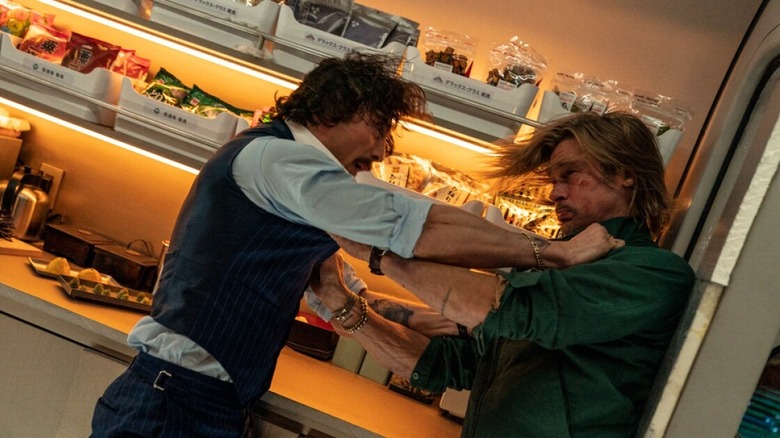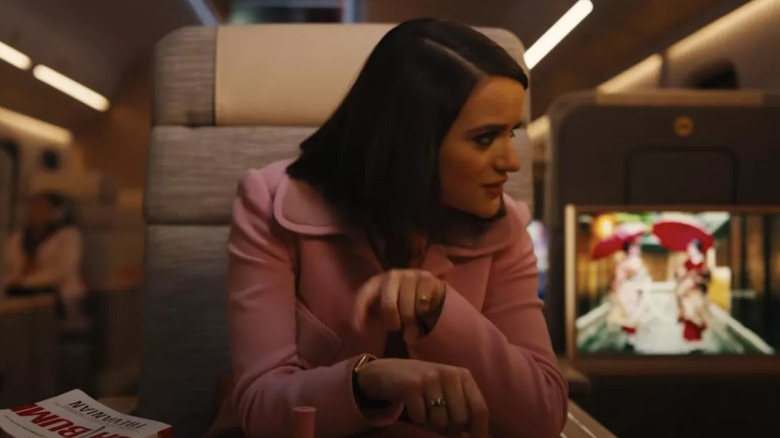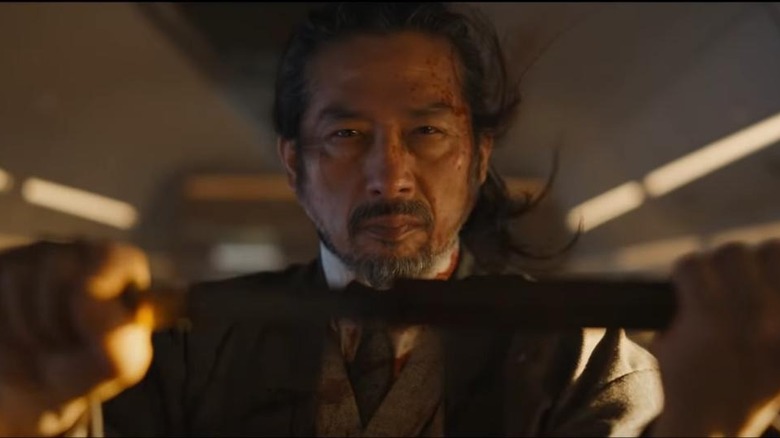The 7 Best And 7 Worst Moments In Bullet Train
David Leitch's new film, "Bullet Train," is one of the best action movies of 2022. Yes, you might complain that it's very similar to "John Wick," but this makes sense, as Leitch was a co-director on the first film in that series. Also, why is that a bad thing? Many action movies from the 1980s and 1990s are clearly influenced by "Die Hard," and quite a few of those are beloved. In 2022, we need more movies that are basically the same as "John Wick," but set in a different location.
Leitch brings the same quippy sense of humor that he added to "Deadpool 2" to "Bullet Train," mixing comedy, action, and character development to create a film that is as equally hilarious as it is vicious. Between sword fights, hand-to-hand combat, and lots of guns, the action sequences in "Bullet Train" are ruthless. However, not every scene is quite as successful. Here are the best and worst moments in "Bullet Train."
Worst: Sandra Bullock's weird cameo
Apparently, there is some sort of running joke between Brad Pitt and Sandra Bullock that we're all missing out on. Earlier this year, Pitt gave a humorous supporting performance in the romantic action comedy "The Lost City," which starred Bullock and Channing Tatum. Pitt played a hyper-masculine character that showed that the actor has a sense of self-awareness.
Bullock apparently wanted to return the favor, and her voice is heard throughout "Bullet Train" as Maria, Ladybug's handler. The addition of Maria is actually one of the stronger running jokes in "Bullet Train." Ladybug can't trust anyone else on the train, so it's nice for him to have someone to open up to, and Bullock and Pitt help create a compelling relationship that you never have to see on screen.
Strangely, Bullock appears in-person at the end of the movie when Maria picks up Ladybug from the wreckage of the crash. What could have been the fulfillment of a great ongoing gag just feels like another joke stuffed into a third act that is already busy enough. It's also a strange case, as Bullock's appearance was spoiled in the film'ssecond trailer. This makes her appearance underwhelming, considering there are actual surprise cameos in the film.
Best: Channing Tatum's cameo
Channing Tatum is apparently also in on this joke; hopefully, these three actors have a string of upcoming projects that they are working on together! Tatum pops up for a genuinely surprising cameo as a clueless passenger that Ladybug runs into.
In this case, Tatum's performance actually improves the material. His appearance relies on a tired joke, as Tatum's character misinterprets comments made by Ladybug and Lemon (Brian Tyree Henry) as sexual references. However, Tatum completely sells the idea that he genuinely has no idea what is going on, subverting our expectations. At this point in the story, Ladybug has run into a lot of old enemies; it's not implausible that another one of his rivals would be out for vengeance. Given Tatum's history in action films, he would seem like a natural choice to play one of the other assassins in the "Bullet Train" universe. However, he's just playing a normal guy!
Worst: The Son's death
The MacGuffin that all of the assassins in "Bullet Train" are trying to get their hands on is a mysterious case filled with cash, which is set to be delivered to a Russian mobster known as the "White Death" (Michael Shannon). At the beginning of the film, the case is in the possession of Lemon and Tangerine (Aaron Taylor-Johnson), a pair of assassins known as "The Twins." In addition to delivering the case to the White Death, they're also charged with protecting his son (Logan Lerman).
A mysterious briefcase is not necessarily an original plot device, but it's the perfect way to get all of the characters on board the train, and it gives them something to do as they slowly figure out that they've all been set up to kill each other. However, adding the fate of an actual character's life into the mix adds an extra wrinkle, and spending time with the Son might have been an interesting way to explore the White Death's backstory.
Unfortunately, the Son is killed fairly early in the film. That's disappointing, considering that the role could have been a great showcase for Lerman. Although many viewers know Lerman as Percy Jackson from the disastrous fantasy franchise, he has grown tremendously as an actor since then. Many of Lerman's best performances have been in smaller films, so it would have been nice to see him give a meaty supporting performance in a major summer blockbuster.
Best: Ladybug's opening scene
"Bullet Train" has a great conceit for an action film. The film takes place on a speeding train that is traveling between Tokyo and Kyoto. Although there are flashbacks and interludes that take place at different points in the timeline, most of the film is set aboard the train, forcing Leitch to get creative with the action sequences. The characters don't want to panic the passengers, because the train is still on a set course, and the story finds a number of reasons to prevent the characters from departing the train at any of the stops.
However, the audience gets a brief glimpse into the outside world when Ladybug travels to the train station in Tokyo, talking on the phone with Maria, and reminisces about his bad luck and work history. What could have easily been a dull expositional sequence actually provides some critical information about the direction that Ladybug's arc is headed. He's not particularly invested in this mission, and he feels that he's been doomed from the beginning.
Leitch is also just a great visual filmmaker, and the use of a cover version of the Bee Gees' "Stayin' Alive" adds a comic element to the scene. From the beginning, it's clear that "Bullet Train" isn't going to be taking itself too seriously.
Worst: Kimura in the hospital
It's a good thing that Ladybug's extended introduction is so much fun, because the actual opening sequence in "Bullet Train" feels like it was taken out of a completely different movie. The film opens with a scene in a hospital, where the Japanese assassin Yuichi Kimura (Andrew Koji) swears to get revenge on the person who pushed his son from a roof. It is very serious, and sets up a vengeance storyline that isn't very interesting. The audience doesn't really get to know anything about Kimura's relationship with his son, Wataru (Kevin Akiyoshi Ching). Perhaps if the film had spent time developing a nurturing relationship between the two, these scenes would have been more interesting.
The hospital scene's placement in the story is also strange. It would have worked better if it had been included as a flashback, after the audience had already started to empathize with Kimura; the more electrifying sequence with Ladybug would have served as a more satisfying opening scene, too.
Best: Prince threatens Kimura
The audience learns that Kimura is a character worth investing in after he encounters "Prince" (Joey King). At a first glance, Prince appears to just be an average schoolgirl on a late night trip. However, this is actually part of a genius disguise. Prince is one of the most dangerous characters in the film, in large part because she is constantly underestimated. Prince tells Kimura that if he doesn't follow her orders, she will send an assassin to kill his son.
This scene is important because of what it reveals about both characters. Even if we hadn't seen the earlier moment in the hospital, Kimura's desire to protect his child shows how dedicated he is to being a great father. Throughout the film, Kimura is reminded of the importance of his family's legacy by his own father, the Elder (Hiroyuki Sanada). Although Kimura makes a lot of mistakes, his respect for his family is never in doubt.
This moment also establishes the ease with which Prince is able to deceive the other characters. She's constantly taken for granted, and many characters pay the price for not suspecting her maliciousness.
Worst: The extended product placement
"Bullet Train" is distributed by Sony Pictures; as a result, you see many, many Sony products in the film. This is especially apparent in the opening moments in Tokyo. Many wide shots that feature large billboards and advertisements featuring well-known brands. It's blatant, but at least this is a natural way to incorporate advertising into the film; it is not quite as distracting as the excessive product placement in Sony's "The Amazing Spider-Man" and the James Bond movies.
However, there is a scene at the end of the film that revolves around a Fiji water bottle, which has remained intact throughout all of the action sequences. In theory, this is a funny idea. Unfortunately, the way it plays out on screen feels more like an extended advertisement than a clever joke.
Best: Lemon and Tangerine's intro
Lemon and Tangerines' chemistry is easily one of the best aspects of "Bullet Train." If there are any characters in the film that we'd like to see get their own spinoff franchise, it's these two. Their repertoire is established early on, when they discuss their mission to protect the Son. Lemon discusses his interest in the children's television program "Thomas & Friends," and his comparisons to the show grow increasingly ridiculous as the action gets more hectic.
Although there are a few interludes that show Lemon and Tangerines' past adventures together, their introductory scene already tells us everything that we need to know about their relationship. Both men clearly care about each other more than they are willing to admit. They've grown so used to talking to each other about the nature of their jobs that they don't stop to think about how strange their lifestyle really is. Considering that their relationship takes a more serious direction later on, it's nice to have a more comedic moment at the beginning.
Worst: Ladybug vs. Hornet
It was exciting to learn that Zazie Beetz was joining the cast of "Bullet Train." She was among the standouts in Leitch's "Deadpool 2," and it seemed like she would be getting another great action role here. In "Bullet Train," Beetz co-stars as "Hornet," an assassin who is renowned for her use of lethal poisons. A plot twist reveals that Hornet is actually the one who killed the Son, and she's also responsible for the bloody massacre at the Wolf's (Benito A Martínez Ocasio) wedding.
However, Hornet's role in the story isn't revealed until towards the end of the film. At this point, there have already been so many double crosses and betrayals that adding another character simply makes the film feel bloated. In addition, because it takes so long to bring in Hornet, her eventual face off with Ladybug holds no dramatic tension. It's evident that Ladybug is going to survive, so there's no real sense of danger.
Ladybug ultimately emerges from the battle victorious, as he's able to use Hornet's own poison against her, and she's failed to bring a back-up antidote. The film acknowledges that this is strange, but that doesn't excuse the lazy storytelling.
Best: Lemon finds Tangerine
"Bullet Train" is only somewhat successful when it comes to pulling the audience's heartstrings. The film doesn't take itself very seriously, but the few moments where the characters show affection for each other are surprisingly effective, and the film's emphasis on the importance of familial bonds mostly works. The Elder wants to pass on his family's legacy to Kimura, while Prince rebels against White Death for being a terrible father.
However, the most powerful relationship in "Bullet Train" isn't a paternal bond, but a fraternal one. Lemon and Tangerine are referred to as "brothers." Although both characters enjoy insulting each other, they genuinely fear for the other's survival. However, during a chaotic standoff, Ladybug ends up killing Tangerine, and Lemon is absolutely devastated when he finds his brother's body. This is counterbalanced by a moment earlier in the story, during which Tangerine finds Lemon lying unconscious after drinking the Fiji water with a sleeping pill. His response was similarly emotional.
Although Lemon's references to "Thomas & Friends" are mostly played for laughs, he lovingly refers to his departed brother as "Thomas." It's as if Lemon wasn't willing to admit how much he cared about Tangerine until he was gone.
Worst: White Death's backstory
The entire film builds towards the climactic battle in Kyoto, where the White Russian and his gang of assassins await the arrival of the titular train. Along the way, "Bullet Train" does a great job at hinting at the White Death's backstory, but without revealing everything at once. At one point, Ladybug even jokes that he's tired of hearing about everyone's origins. The Elder promises him that his story will be a short one, and explains how the White Death rose to power. The flashback footage, which masks White Death's face, is absolutely haunting.
However, when the White Death confronts Ladybug, he proceeds to explain in detail how he orchestrated all of the events in the film, and discusses how the assassins are linked to the death of his wife. This exposition dump doesn't match the subversive nature of the rest of the film. White Death's extended monologue feels like the exact type of "cliched villain speech" that Deadpool character would make fun of.
Ironically, Deadpool himself, Ryan Reynolds, actually does show up in a flashback as Carver, the assassin whose identity Ladybug has been using. It's not a particularly funny cameo; it feels like Reynolds is always playing the "fast-talking action hero," so we really didn't need to see him pop up in another action comedy.
Best: Ladybug vs. Tangerine
Tangerine's battle with Ladybug is one of the most creative action sequences in the film, and the scene doesn't shy away from brutality. They're both highly-trained warriors, after all. Ladybug is trying to convince Tangerine that he's telling the truth, but the British assassin has heard enough of his lies. His anger with Ladybug's carefree attitude has reached its breaking point.
To give both the characters and the audience a moment to breathe, there is a brief moment where the fight is interrupted by the train's charming concession worker (Karen Fukuhara). Ladybug uses the interruption as an opportunity to irritate Tangerine. He spends extra time picking out a fizzy water bottle, and then forces Tangerine to pay for it. Of course, this was also a strategic move on Ladybug's part; after the concession worker leaves, he hurls the water bottle at Tangerine's head.
There's a fair amount of gunplay and sword fights in the film, so it's refreshing to have a fight scene that is mostly hand-to-hand combat. Pitt clearly understood the importance of authenticity, too — he did his own stunts for the film.
Worst: Prince's death
Despite her promising introduction, Prince doesn't add very much to the end of "Bullet Train." The revelation that she is really White Death's daughter is strangely wedged into an ending that is already complicated enough. Prince feels that her father never appreciated her in the same way that he did his son, but we never get a good idea of what their family dynamic looked like. Perhaps, if King got to share a few scenes with Lerman, her motivations would have made more sense.
Still, Prince somehow manages to survive the train crash, and threatens to kill Ladybug. Then, she is abruptly run over by a truck. It's not a particularly funny joke; the film has already spent enough time discussing Ladybug's luck (or lack thereof). It's also a strange way to conclude Prince's character arc. Despite being completely calm and collected for the majority of the film, Prince's threats against Ladybug are completely unhinged. It might have been more satisfying if Prince had gotten to spend a little more time with her father.
However, this moment is somewhat redeemed by a stinger that plays after the title card: It is revealed that Lemon survived the crash, and ended up driving the truck that killed Prince.
Best: White Death vs. the Elder
"Bullet Train" does a great job at building an aura of mystique around the White Death. He is the most fearsome character in the film, and it's interesting that Leitch chooses to not reveal Shannon's face until the very end. Shannon's Russian accent is also perfect — it's just goofy enough to remind you that this is still an action-comedy. However, the Elder's mission to kill the White Death is taken completely seriously. He's not just putting his life on the line; he is risking his honor and his family legacy. White Death reveals to Ladybug later on that he is also looking to honor his family, and that he's gathered these assassins to avenge his dead wife.
Their duel is the most exciting part of the third act; Ladybug and Lemons' misadventures as they try to stop the train aren't nearly as entertaining. Even though the situation is ridiculous, the actual choreography looks very convincing. Some of the computer-generated-imagery in the final action sequence doesn't look that great, but the duel is more focused on the emotion and performances anyway. The only real drawback is that the train crash disrupts the end of the fight.
